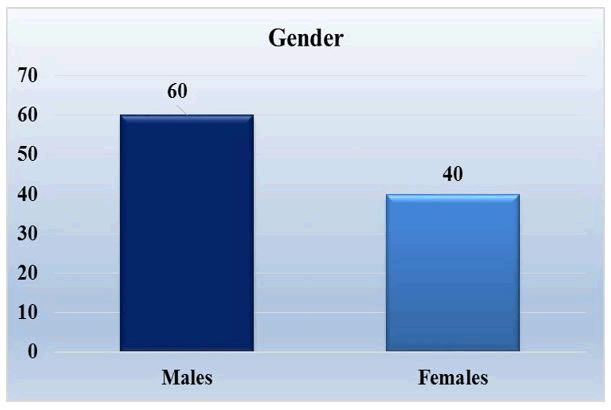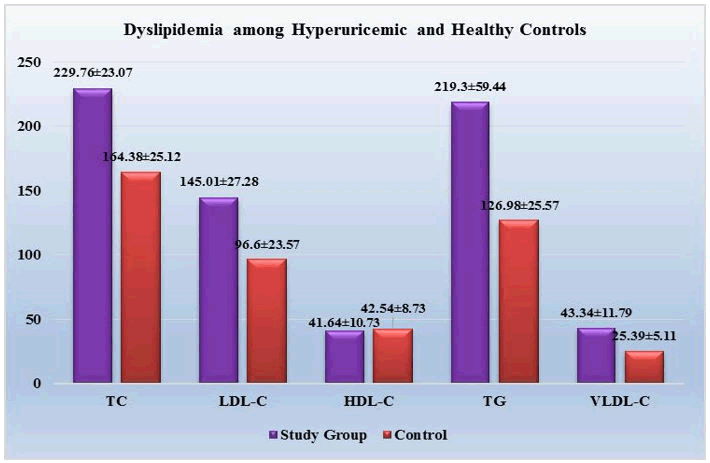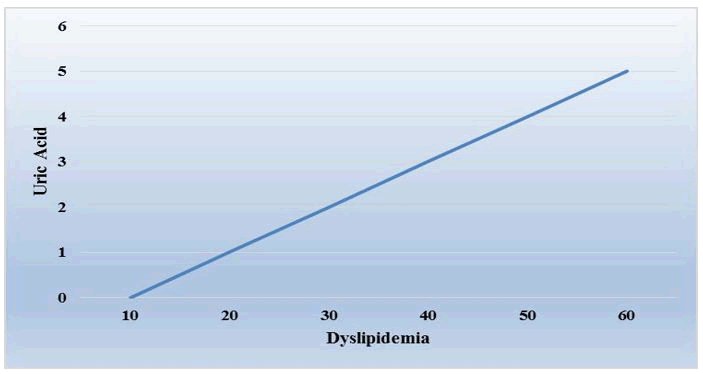Dyslipidemia in Hyperuricemia Patients: A Hospital Based Study
Received: 24-Sep-2022, Manuscript No. AMHSR-22-72875; Editor assigned: 27-Sep-2022, Pre QC No. AMHSR-22-72875 (PQ); Reviewed: 11-Oct-2022 QC No. AMHSR-22-72875; Revised: 24-Dec-2022, Manuscript No. AMHSR-22-72875 (R); Published: 03-Jan-2023
Citation: Tyagi S. Dyslipidemia in Hyperuricemia Patients A Hospital Based Study. Ann Med Health Sci Res. 2023;13:1-4
This open-access article is distributed under the terms of the Creative Commons Attribution Non-Commercial License (CC BY-NC) (http://creativecommons.org/licenses/by-nc/4.0/), which permits reuse, distribution and reproduction of the article, provided that the original work is properly cited and the reuse is restricted to noncommercial purposes. For commercial reuse, contact reprints@pulsus.com
Abstract
The inal oxidation product of purine catabolism in humans is Serum uric acid. Excessive production of uric acid and its reduced excretion by the kidneys is the central feature of the clinical state termed, hyperuricemia. The present study was conducted in the department of biochemistry, Subharti medical college, Meerut; after obtaining ethical clearance by the Institutional Ethical Committe (IEC). The present study included patients attending medicine OPD (outpatient department) and IPD (inpatient department); out of which 50 were freshly diagnosed cases of hyperuricemia. The control group included age and sex matched healthy 50 individuals. The present study was done to determine the extent of dyslipidemia in hyperuricemic patients. Association of dyslipidemia and hyperuricemia has been the long interest of researchers. The study does not include patients with known case of coronary artery disease, chronic renal disease, chronic liver disease, diabetes mellitus, and mentally unstable/uncooperative patients. Patients carrying pregnancy and other comorbid condition were also excluded from the study. Our study shows the directly proportional relation between dyslipidemia and hyperuricemia.
Keywords
Hyperuricemia; Cardio Vascular Disease (CVD); Pregnancy; Diabetes Mellitus
Introduction
The final oxidation product of purine catabolism in humans is Serum uric acid [1]. Excessive production of uric acid and its reduced excretion by the kidneys is the central feature of the clinical state termed, hyperuricemia [2,3]. Recent reports showed that hyperuricemia is correlated with Cardio Vascular Disease (CVD), hypertension, diabetes and metabolic syndrome. It is also promoted by consumption of alcohol, smoking, diet rich in red meat and obesity [4]. Hyperuricemia act as arbitrator of pro-inflammatory endocrine imbalance in the adipose tissue which can be an important cause of dyslipidemia, leading to atherogenesis.
Many studies were done to assess the lipid profile status of hyperuricemic patients. But controversies still prevail and that needs to attain consensus. So, we have designed this study in our population (Western UP) for evaluation of lipid profile in hyperuricemic patients that might be helpful for clinical management of hyperuricemic patients with dyslipidemia. Also early diagnosis and proper management can significantly reduce the mortality and morbidity of dyslipidemic cardiovascular diseases.
Materials and Methods
The present study was conducted in the department of biochemistry, Subharti medical college, and Meerut; after obtaining Ethical clearance by the Institutional Ethical Committe (IEC). Data Collection Tickets (DCT) were specifically designed and sufficient copies were prepared. Patients attending OPD (Out Patient Department) and IPD (In patient Department) of medicine department, Chhatrapati Shivaji Subharti (CSS) Hospital were enrolled for the present study. Informed consent was taken from each individual patient. General information including name, age, sex, contact details etc. were noted in DCT for each patient. Detailed history including present complaints, past history, family history, history of medicine intake, previous illness and other relevant information was taken from each individual patient and recorded.
Inclusion criteria
Study group: Only newly diagnosed cases of hyperuricemia, both sexes (clinically and biochemically) within the age group of 18 to 80 years with no history of intake of hypolipidemic drugs in the last 3 months were included in the study.
Exclusion criteria
If any of the patient, was having any of the following known condition, was not included in the study:
• Coronary artery disease.
• Chronic renal disease.
• Chronic liver disease.
• Diabetes mellitus.
• Mentally unstable/uncooperative patient.
• Pregnancy.
• Patients having other comorbid condition were also excluded from the study.
Control group
Healthy volunteers and employees of C.S.S Hospital, Meerut; age and sex matched were subjected to the entire process of informed consent, history taking, routine and systematic examination and routine investigations.
Method of estimation
Estimation for lipid profile and uric acid levels was done by automatic biochemistry analyzer (Siemens Dimension Rxl max).
Sample collection and preparation
Venous blood sample was drawn from the antecubital vein under all aseptic condition, after overnight fasting of 10 to 12 hours. 4 ml of blood sample was collected in plain vial for lipid profile (TC, HDL-C, LDL-C, TG-C and VLDL-C) and Uric acid levels. The collected sample was first coagulated and then centrifuged at 3000 rpm for 15 minutes. Supernatant serum was then carefully transferred to disposable cuvettes for respective investigations.
Statistical analysis
The information and data so collected was subjected to statistical analysis. Mean, standard deviation, Students (T) Test and Pearson correlation coefficient (R) were mainly applied. P-value less than 0.05 was considered to be statistically significant (Tables 1 and 2).
| Table 1: Diagnostic criteria for lipid profile. | |
| Investigations | Ref. value |
|---|---|
| S. Cholesterol | <200 mg/dl desirable |
| 200-239 mg/dl borderline | |
| >240 mg/dl high | |
| S. Triglyceride | <150 mg/dl |
| H.D.L | Male:>40 mg/dl |
| Female:>50 mg/dl | |
| L.D.L | <100 mg/dl optimal |
| 100-129 mg/dl above optimal 130-159 mg/dl borderline 160-189 mg/dl high | |
| >190 mg/dl very high | |
| V.L.D.L | <30 mg/dl |
| Table 2: Diagnostic criteria for uric acid levels. | |
| Investigations | Ref. Value |
|---|---|
| S. Uric Acid | 2.6-6.0 mg/dl |
Results
The present study included patients attending medicine OPD (Outpatient Department) and IPD (In Patient Department); out of which 50 were freshly diagnosed cases of hyperuricemia. The control group included age and sex matched healthy 50 individuals. The results and observations of the study are shown in the following Table 3 and Figures 1-3.
| Table 3: Results of physiological and biochemical parameters. | ||
| Parameters | Control Group (n=50) (Mean ± SD) | Study Group (n=50) (Mean ± SD) |
|---|---|---|
| Age | 44.24 ± 16.64 | 46.32 ± 15.89 |
| Male: Female ratio | 28:22:00 | 30:20:00 |
| Total cholesterol (mg/dl) | 164.38 ± 25.12 | 229.76 ± 23.07a |
| LDL-C (mg/dl) | 96.6 ± 23.57 | 145.014 ± 27.28a |
| HDL-C (mg/dl) | 42.54 ± 8.73 | 41.64 ± 10.73 |
| Triglycerides (mg/dl) | 126.98 ± 25.57 | 219.3 ± 59.44a |
| VLDL-C (mg/dl) | 25.396 ± 5.11 | 43.344 ± 11.79a |
| Uric Acid (mg/dl) | 4.834 ± 1.13 | 8.32 ± 1.13a |
a=values significant (p value<0.05) when unpaired t test was applied between control and the cases.
Discussion
The present study was done to determine the extent of dyslipidemia in hyperuricemic patients. Association of dyslipidemia and hyperuricemia has been the long interest of researchers. Some studies are available in the literature in which researchers have assessed the individual parameters like uric acid, lipid profile but hardly any available study includes the correlation of hyperuricemia with dyslipidemia in western UP. This generated our interest in this direction. So this study was planned and conducted in SVSU, associated CSS hospital; findings of which are discussed below: The study does not include patients with known case of coronary artery disease, chronic renal disease, chronic liver disease, diabetes mellitus, and mentally unstable/ uncooperative patients. Patients carrying pregnancy and other comorbid condition were also excluded from the study[5].
Demographic
Fifty patients attending medicine OPD and IPD, were studied for the study group, out of which 20 were females and 30 were males. Also 50 healthy age and sex matched controls were taken for the comparison, out of which 22 were females and 28 were males. It was found that majority of patients suffering from hyperuricemia were males. Similar findings were observed [6,7]. This may be due to the effect of protein rich diet, more muscular mass present in the males and lifestyle behaviors causing obesity. In the present study, TCC, LDL-C, TG-C and VLDL-C were found to be significantly higher in the study group. Hence, it is drawn that serum uric acid levels are strongly associated with the serum TC-C, LDL-C, TG-C and VLDL-C levels. Many studies supported our findings [8]. The levels of HDL-C were found to be non-significantly higher in healthy controls when compared with the study group, which shows that serum HDL-C is inversely related to the serum uric acid levels. Our findings were supported who further postulated that the reduced HDL-C levels results in the formation of atherosclerosis and increase CVD risk [9].
Conclusion
Our study shows the directly proportional relation between dyslipidemia and hyperuricemia. Thus, showing the atherosclerotic and CVD risk in these cases. In our study we found dyslipidemia in hyperuricemic patients but it needs more research in different communities and on relatively large sample sizes. Therefore, by treating hyperuricemic patients through restricting fat rich diet and lifestyle modifications, we can prevent cardiovascular diseases in these patients.
References
- Glantzounis G, Tsimoyiannis E, Kappas, Galaris D. Uric acid and oxidative stress. Curr Pharm Des. 2005;11:4145-4151.
[Crossref] [Google Scholar] [PubMed]
- Liu R, Han C, Wu D, Xia X, Gu J, Guan H, et al. Prevalence of Hyperuricemic and Gout in Mainland China from 2000 to 2014: A Systematic Review and Meta-Analysis. Biomed Res Int. 2015;15:762820.
[Crossref] [Google Scholar] [PubMed]
- Remedios C, Shah M, Bhasker AG, Lakdawala M. Hyperuricemia: A reality in the Indian obese. Obese Surg. 2012; 22:945-948.
[Crossref] [Google Scholar] [PubMed]
- Kanbay M, Jensen T, Solak Y, Le M, Roncal-Jimenez C. Uric acid in metabolic syndrome: from an innocent bystander to a central player. Eur J Intern Med. 2016;29:3-8.
[Crossref] [Google Scholar] [PubMed]
- Baldwin W, McRae S, Marek G, Wyler D, Pannu V, Baylis C, et al. Hyperuricemia as a mediator of the proinflammatory endocrine imbalance in the adipose tissue in a minute model of the metabolic syndrome. Diabetes. 2011;100916.
[Crossref] [Google Scholar] [PubMed]
- Poletto J, Harima HA, Ferreira SRG, Gimeno SGA. Hyperuricemia and associated factors: a crossectional study of Japanese-Brazilians. Cad Saude Publica. 2011;27:369-378.
[Crossref] [Google Scholar] [PubMed]
- Nagahama K, Iseki K, Inoue T, Touma T, Ikemiya Y, Takishita S, et al. Hyperuricemia and Cardiovascular Risk Factor Clustering in a Screened Cohort in Okinawa. Japan Hypertenes Res 2004:27:227-233.
[Crossref] [Google Scholar] [PubMed]
- Lippi G, Montagnana M, Luca Salvagno G,Targher G, Cesare GG. Epidemiological association between uric acid concentration in plasma, lipoprotein (a), and the traditional lipid profile. Clin Cardiol. 2010; 33:76-80.
[Crossref] [Google Scholar] [PubMed]
- Peng TC, Wang CC, Kao TW, Chan JYH, Yang YH, Chang YW et al. Relationship between hyperuricemia and lipid profiles in US adults. Biomed Res Int. 2015;2015:127596.
[Crossref] [Google Scholar] [PubMed]







 The Annals of Medical and Health Sciences Research is a monthly multidisciplinary medical journal.
The Annals of Medical and Health Sciences Research is a monthly multidisciplinary medical journal.